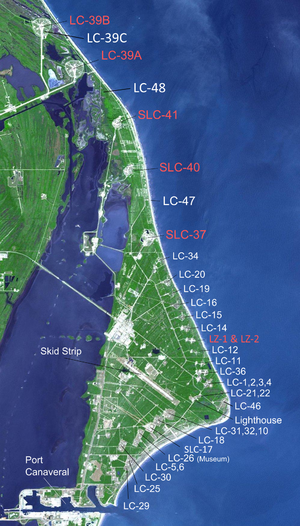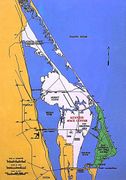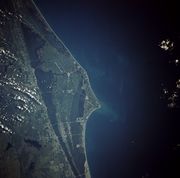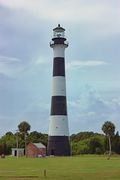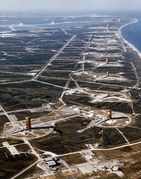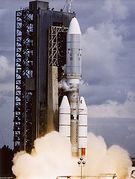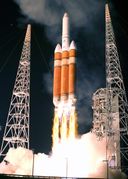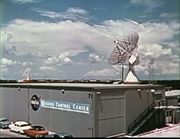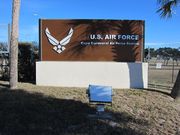قاعدة كيپ كناڤرال للقوات الجوية
| Cape Canaveral Air Force Station | |||||||
|---|---|---|---|---|---|---|---|
| جزء من قاعدة پاترك للقوات الجوية | |||||||
| بالقرب من كوكو بيتش، فلوريدا في الولايات المتحدة | |||||||
 | |||||||
| الإحداثيات | 28°29′20″N 80°34′40″W / 28.48889°N 80.57778°W | ||||||
| النوع | محطة للقوات الجوية الأمريكية | ||||||
| المساحة | 1،325 acre (5 km2)[1] | ||||||
| معلومات الموقع | |||||||
| المالك | Department of Defense | ||||||
| المشغل | United States Space Force | ||||||
| يتحكم فيه | 45th Space Wing | ||||||
| الموقع الإلكتروني | www.patrick.af.mil/ | ||||||
| تاريخ الموقع | |||||||
| بُني | 1949 (as the Joint Long Range Proving Ground) | ||||||
| قيد الاستخدام | 1949 – present | ||||||
| معلومات الحامية | |||||||
| الحامية | 45th Space Wing | ||||||
| معلومات مدرج جوي | |||||||
| المميزات | ICAO: KXMR، FAA LID: XMR | ||||||
| الارتفاع | 3 متر (10 ft) فوق سطح البحر | ||||||
| |||||||
| المصدر: إدارة الطيران الفدرالية[2] | |||||||
قاعدة كيپ كناڤرال للقوات الجوية | |||||||
| الموقع | كيپ كناڤرال، فلوريدا، الولايات المتحدة | ||||||
| بُنيَ | 1950+[3] | ||||||
| الزوار | Not open to the public | ||||||
| رقم NRHP المرجعي | خطأ لوا: invalid capture index %2 in replacement string. | ||||||
| تواريخ بارزة | |||||||
| أضيف إلى NRHP | April 16, 1984 | ||||||
| Designated NHLD | April 16, 1984[4] | ||||||
محطة كيپ كناڤرال للقوات الجوية (Cape Canaveral Air Force Station وتُختصر CCAFS كما كانت تُعرف بإسم محطة كيپ كندي للقوات الجوية من 1963 حتى 1973) هي تمركز الجناح 45 الفضائي التابع للقوات الجوية الأمريكية.
The facility was scheduled to be renamed Cape Canaveral Space Force Station (CCSFS) in March 2020,[6][7] but the renaming was postponed indefinitely because of the COVID-19 pandemic.[8]
قيادة CCAFS توجد في قاعدة پاترك للقوات الجوية المجاورة، بينما منشآتها توجد في كيپ كناڤرال في Brevard County, Florida, CCAFS. The station is the primary launch head of America's Eastern Range[9] with three launch pads currently active (Space Launch Complexes 37B, 40, and 41). Popularly known as "Cape Kennedy" from 1963 to 1973, and as "Cape Canaveral" from 1949 to 1963 and from 1973 to the present, the facility is south-southeast of NASA's Kennedy Space Center on adjacent Merritt Island, with the two linked by bridges and causeways. The Cape Canaveral Air Force Station Skid Strip provides a 10،000-قدم (3،000 m) runway[10] close to the launch complexes for military airlift aircraft delivering heavy and outsized payloads to the Cape.
A number of American space exploration pioneers were launched from CCAFS, including the first U.S. Earth satellite in 1958, first U.S. astronaut (1961), first U.S. astronaut in orbit (1962), first two-man U.S. spacecraft (1965), first U.S. unmanned lunar landing (1966), and first three-man U.S. spacecraft (1968). It was also the launch site for all of the first spacecraft to (separately) fly past each of the planets in the Solar System (1962–1977), the first spacecraft to orbit Mars (1971) and roam its surface (1996), the first American spacecraft to orbit and land on Venus (1978), the first spacecraft to orbit Saturn (2004), and to orbit Mercury (2011), and the first spacecraft to leave the Solar System (1977). Portions of the base have been designated a National Historic Landmark for their association with the early years of the American space program.[11]
التاريخ
The CCAFS area had been used by the United States government to test missiles since 1949, when President Harry S. Truman established the Joint Long Range Proving Ground at Cape Canaveral.[12] The location was among the best in the continental United States for this purpose, as it allowed for launches out over the Atlantic Ocean, and is closer to the equator than most other parts of the United States, allowing rockets to get a boost from the Earth's rotation.
حقل تجارب للقوات الجوية
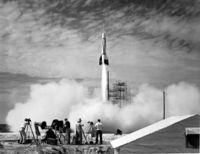
NASA's Launch Services Program (LSP) is responsible for oversight of launch operations and countdown management for all uncrewed launches at Cape Canaveral which it does not operate.
بوينگ X-37B
The Boeing X-37B, a reusable uncrewed spacecraft operated by USAF which is also known as the Orbital Test Vehicle (OTV), has been successfully launched four times from Cape Canaveral.[13] The first four X-37B missions have been launched with Atlas V rockets. Past launch dates for the X-37B spaceplane include April 22, 2010, March 5, 2011, December 11, 2012, and May 20, 2015. The fourth X-37B mission landed at the Kennedy Space Center on May 7, 2017, after 718 days in orbit. The first three X-37B missions all made successful autonomous landings from space to a 15،000 قدم (4،600 m) runway located at Vandenberg Air Force Base in California which was originally designed for Space Shuttle return from orbit operations.
العمليات والبنية التحتية والمنشآت
Of the launch complexes built since 1950, several have been leased and modified for use by private aerospace companies. Launch Complex SLC-17 was used for the Delta II Heavy variant, through 2011.[14] Launch Complexes SLC-37 and SLC-41 were modified to launch EELV Delta IV and Atlas V launch vehicles, respectively.[15] These launch vehicles replaced all earlier Delta, Atlas, and Titan rockets. Launch Complex SLC-47 is used to launch weather sounding rockets. Launch Complex SLC-46 is reserved for use by Space Florida.[16]
SLC-40 hosted the first launch of the SpaceX Falcon 9 in June 2010.[17] Falcon 9 launches continued from this complex through 2015, consisting of unmanned Commercial Resupply Services missions for NASA to the International Space Station as well as commercial satellite flights. SpaceX has also leased Launch Complex 39A from NASA and has completed modifying it to accommodate Falcon Heavy and Commercial Crew manned spaceflights to the ISS with their Crew Dragon spacecraft in 2019.[18] SpaceX Landing Zone 1 and 2, used to land first stages of the Falcon 9 and the side boosters of the Falcon Heavy, are located at the site of the former LC-13.
On September 16, 2015, NASA announced that Blue Origin has leased Launch Complex 36 and will modify it as a launch site for their next-generation launch vehicles.[19][needs update]
In the case of low-inclination (geostationary) launches the location of the area at 28°27'N put it at a slight disadvantage against other launch facilities situated nearer the equator. The boost eastward from the Earth's rotation is about 406 m/s (908 أميال في الساعة) at Cape Canaveral, but 463 m/s (1،035 أميال في الساعة) at the European Guiana Space Centre in French Guiana.[20]
In the case of high-inclination (polar) launches, the latitude does not matter, but the Cape Canaveral area is not suitable, because inhabited areas underlie these trajectories; Vandenberg Air Force Base, Cape Canaveral's West coast counterpart, or the smaller Pacific Spaceport Complex – Alaska (PSCA) are used instead.
The Air Force Space and Missile Museum is located at LC-26.[21] Hangar AE, located in the CCAFS Industrial Area, collects telemetry from launches all over the United States. NASA's Launch Services Program has three Launch Vehicle Data Centers (LVDC) within that display telemetry real-time for engineers.
مدرج انزلاق قاعدة كيپ كناڤرال للقوات الجوية
The runway was first called the Skid Strip because SM-62 Snark cruise missiles (which lacked wheels) returning from test flights were supposed to skid to a halt on it.[22]
In the 1960s the Douglas C-133 Cargomaster was a frequent visitor, carrying modified Atlas and Titan missiles, used as launch vehicles for crewed and uncrewed space programs leading to the Apollo Moon landings. The Skid Strip was used by NASA's Pregnant Guppy and Super Guppy transport aircraft carrying the S-IVB upper stage for the Saturn IB and Saturn V rockets used in Apollo program.
Today, it is predominantly used by USAF C-130 Hercules, C-17 Globemaster III and C-5 Galaxy aircraft transporting satellite payloads to CCAFS for mating with launch vehicles.
The CCAFS Skid Strip is sometimes confused with the NASA Shuttle Landing Facility, but that runway, specially constructed for the Space Shuttle, is located on Merritt Island at the adjacent of Kennedy Space Center.
وحدة اختبار الذخيرة البحرية
A tenant command located at Cape Canaveral AFS is the U.S. Navy's Naval Ordnance Test Unit (NOTU). As a major shore command led by a Navy captain, NOTU was created in 1950 and initially directed almost all of its efforts towards the development and subsequent support of the submarine-launched Fleet Ballistic Missile (FBM) program. This resulted in NOTU being assigned to the Director, Special Projects (now Strategic Systems Programs) with a mission to support the development of the Polaris missile and later the Poseidon missile programs.[23]
NOTU's mission is the support and testing of sea-based weapons systems for the United States Navy and the Royal Navy in a safe environment utilizing the airspace and waterspace of the Eastern Range. The command directly supports the mission capability and readiness of the United States Navy's Trident Submarines as well as the Fleet Ballistic Missile program of the United Kingdom. NOTU operates the Navy Port at Port Canaveral, supporting submarines and surface ships of the U.S. Atlantic Fleet, NATO, Allied and other foreign navies, and assets of the Military Sealift Command. NOTU is composed of over 100 active duty U.S. Navy personnel and over 70 defense contractors.[23][24]
ماء الشرب
The base obtains potable water from the city of Cocoa. A single potable water line from Cocoa runs under the Sykes Creek Bridge at Sea Ray Drive.[25][26]
الوحدات المتمركزة
Flying (e.g., USAF space vehicle, not USAF aircraft) and notable non-flying units are based at Cape Canaveral Air Force Station.[27][28]
Units marked GSU are Air Force Geographically Separate Units which, although based at Cape Canaveral AFS, are subordinate to the 45th Space Wing headquarters at Patrick AFB.
قوة الفضاء الأمريكية
- Fourteenth Air Force
- 45th Space Wing
- 45th Launch Group (GSU)
- 5th Space Launch Squadron – Atlas V and Delta IV
- 45th Launch Support Squadron (Deactivated and merged with 5th SLS Late 2018)
- 45th Operations Group (GSU)
- 45th Range Squadron
- 45th Space Communications Squadron
- 45th Weather Squadron
- 45th Launch Group (GSU)
- 45th Space Wing
البحرية الأمريكية
- Naval Ordnance Test Unit
معرض صور
Titan III-E launches Voyager 2 probe in 1977 from SLC-41
First Delta IV Heavy booster launches from SLC-37 in 2007
انظر أيضاً
المراجع
- ^ أ ب "National Register Information System – (#84003872)". National Register of Historic Places. National Park Service. يوليو 9, 2010.
- ^ "Cape Canaveral AFS Skid Strip (KXMR)" (PDF). Federal Aviation Administration. 12 September 2019. Retrieved 14 September 2019.
- ^ "Cape Canaveral Air Force Station". Florida Heritage Tourism Interactive Catalog. Florida's Office of Cultural and Historical Programs. سبتمبر 23, 2007. Archived from the original on December 14, 2007.
- ^ Cape Canaveral Air Force Station Archived يناير 13, 2009 at the Wayback Machine at National Historic Landmarks Program.
- ^ "Patrick Air Force Base – FAQ Topic". Patrick Air Force Base. Archived from the original on November 17, 2007.
- ^ "Patrick Air Force Base, Cape Canaveral Air Force Station to be Renamed Patrick Space Force Base, Cape Canaveral Space Force Station |". spacecoastdaily.com. Retrieved February 13, 2020.
- ^ "Patrick AFB in Florida will be first facility renamed under Space Force". UPI. Retrieved February 13, 2020.
- ^ Dunn, Marcia (March 26, 2020). "Space Force launches its first mission with virus precautions". CTV News. Retrieved 14 May 2020.
- ^ CAST 1999, p. 1-12.
- ^ "World Aero Data: Cape Cnaveral AFS Skid Strip – XMR". Retrieved August 31, 2008.
- ^ [[[:قالب:NHLS url]] "NHL nomination for Cape Canaverl Air Force Station"]. National Park Service. Retrieved 2018-01-11.
{{cite web}}: Check|url=value (help) - ^ "Factsheets : Evolution of the 45th Space Wing". Archived from the original on يونيو 13, 2011.
- ^ "Fact Sheet Display". www.af.mil. Retrieved March 7, 2018.
- ^ CAST 1999, p. 1-26.
- ^ CAST 1999, p. 1-31.
- ^ CAST 1999, p. 1-35.
- ^ SpaceX Corp (October 23, 2009). "Dragon/ Falcon 9 Update". SpaceX. Retrieved November 10, 2009.
- ^ Bergin, Chris (18 February 2015). "Falcon Heavy into production as Pad 39A HIF rises out of the ground". NASASpaceFlight. NASASpaceFLight. Retrieved 19 February 2015.
- ^ Kenneth Chang (September 16, 2015). "Blue Origin, Jeff Bezos' Rocket Company, to Launch from Florida". The New York Times. Retrieved September 16, 2015.
- ^ "Up, Up, and Away". The Universe: In the Classroom. Astro Society. Archived from the original on August 8, 2011. Retrieved August 11, 2011.
- ^ CAST 1999, pp. 1–29 to 1–30.
- ^ Lethbridge, Clifford (1998). "Snark Fact Sheet". Spaceline. Retrieved September 16, 2012.
- ^ أ ب "NOTU Cape Canaveral". www.navymwrcapecanaveral.com. US Navy.
 هذا المقال يضم نصاً من هذا المصدر، الذي هو مشاع.
هذا المقال يضم نصاً من هذا المصدر، الذي هو مشاع.
- ^ Vazquez, Tyler. "Cape Canaveral's NOTU gets homegrown commander". Florida Today.
- ^ "Irma leaves Sykes Creek Bridge in limbo". floridatoday.com.
- ^ Harris, Michael Williams, David. "Brevard barrier island at risk of losing water source after Hurricane Irma". orlandosentinel.com.
{{cite web}}: CS1 maint: multiple names: authors list (link) - ^ "Mission Partners". Patrick AFB. US Air Force. Retrieved 14 September 2019.
{{cite web}}: CS1 maint: url-status (link) - ^ "Fact Sheets". Patrick AFB. US Air Force. Retrieved 14 September 2019.
{{cite web}}: CS1 maint: url-status (link)
المصادر
- "Launch Site Safety Assessment, Section 1.0 Eastern Range General Range Capabilities" (PDF). Research Triangle Institute, Center for Aerospace Technology (CAST), Florida Office. Federal Aviation Administration. مارس 1999. Archived from the original (PDF) on مارس 26, 2009. Retrieved يناير 25, 2010.
وصلات خارجية
 Media related to Cape Canaveral Air Force Station at Wikimedia Commons
Media related to Cape Canaveral Air Force Station at Wikimedia Commons- Patrick Air Force Base
- Cape Canaveral Air Force Station Virtual Tour
- Air Force Space and Missile Museum Web site
- "Cape Canaveral Lighthouse Shines Again" article and video interview about the lighthouse
- Aviation: From Sand Dunes to Sonic Booms, a National Park Service Discover Our Shared Heritage Travel Itinerary
- الفيلم القصير "The Cape (1963)" متاح للتنزيل المجاني على أرشيف الإنترنت [more]
- سجل الهندسة الأمريكية التاريخية (HAER) No. FL-8-5, "Cape Canaveral Air Station, Launch Complex 17, East end of Lighthouse Road, Cape Canaveral, Brevard, FL"
- Key Events in Apollo
- The Launch Pads of Cape Canaveral
قالب:FLMilitary قالب:USAF Space Command
قالب:National Register of Historic Places in Florida قالب:Spaceflight landmarks
- CS1 errors: URL
- CS1 maint: url-status
- Articles with hatnote templates targeting a nonexistent page
- Missing redirects
- Short description with empty Wikidata description
- Pages using gadget WikiMiniAtlas
- Pages using infobox NRHP with unknown parameters
- NRHP infobox with nocat
- Wikipedia articles in need of updating from March 2020
- All Wikipedia articles in need of updating
- Installations of the United States Air Force in Florida
- Cape Canaveral Air Force Station
- Launch complexes of the United States Air Force
- National Register of Historic Places in Brevard County, Florida
- Historic districts on the National Register of Historic Places in Florida
- Spaceports in the United States
- National Historic Landmarks in Florida
- Historic American Engineering Record in Florida
- 1948 establishments in Florida
- Transportation buildings and structures on the National Register of Historic Places
- Transportation buildings and structures on the National Register of Historic Places in Florida

